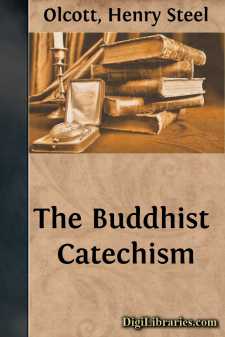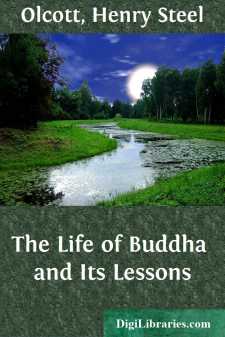Categories
- Antiques & Collectibles 13
- Architecture 36
- Art 48
- Bibles 22
- Biography & Autobiography 813
- Body, Mind & Spirit 142
- Business & Economics 28
- Children's Books 17
- Children's Fiction 14
- Computers 4
- Cooking 94
- Crafts & Hobbies 4
- Drama 346
- Education 46
- Family & Relationships 57
- Fiction 11829
- Games 19
- Gardening 17
- Health & Fitness 34
- History 1377
- House & Home 1
- Humor 147
- Juvenile Fiction 1873
- Juvenile Nonfiction 202
- Language Arts & Disciplines 88
- Law 16
- Literary Collections 686
- Literary Criticism 179
- Mathematics 13
- Medical 41
- Music 40
- Nature 179
- Non-Classifiable 1768
- Performing Arts 7
- Periodicals 1453
- Philosophy 64
- Photography 2
- Poetry 896
- Political Science 203
- Psychology 42
- Reference 154
- Religion 513
- Science 126
- Self-Help 84
- Social Science 81
- Sports & Recreation 34
- Study Aids 3
- Technology & Engineering 59
- Transportation 23
- Travel 463
- True Crime 29
The Buddhist Catechism
Description:
Excerpt
THE LIFE OF THE BUDDHA
1. Question. Of what religion[] are you?
Answer. The Buddhist.
2. Q. What is Buddhism?
A. It is a body of teachings given out by the great personage known as the Buddha.
3. Q. Is "Buddhism" the best name for this teaching?
A. No; that is only a western term: the best name for it is Bauddha Dharma.
4. Q. Would you call a person a Buddhist who had merely been born of Buddha parents?
A. Certainly not. A Buddhist is one who not only professes belief in the Buddha as the noblest of Teachers, in the Doctrine preached by Him, and in the Brotherhood of Arhats, but practises His precepts in daily life.
5. Q. What is a male lay Buddhist called?
A. An UpÃÂsaka.
6. Q. What a female?
A. An UpÃÂsika.
7. Q. When was this doctrine first preached?
A. There is some disagreement as to the actual date, but according to the Sinhalese Scriptures it was in the year 2513 of the (present) Kali-Yuga.
8. Q. Give the important dates in the last birth of the Founder?
A. He was born under the constellation VisÃÂ on a Tuesday in May, in the year 2478 (K.Y.); he retired to the jungle in the year 2506; became Buddha in 2513; and, passing out of the round of rebirths, entered ParanirvÃÂna in the year 2558, aged eighty years. Each of these events happened on a day of full moon, so all are conjointly celebrated in the great festival of the full-moon of the month Wesak (VaisÃÂkha), corresponding to the month of May.
9. Q. Was the Buddha God?
A. No. Buddha Dharma teaches no "divine" incarnation.
10. Q. Was he a man?
A. Yes; but the wisest, noblest and most holy being, who had developed himself in the course of countless births far beyond all other beings, the previous BUDDHAS alone excepted.
11. Q. Were there other Buddhas before him?
A. Yes; as will be explained later on.
12. Q. Was Buddha his name?
A. No. It is the name of a condition or state of mind, of the mind after it has reached the culmination of development.
13. Q. What is its meaning?
A. Enlightened; or, he who has the all-perfect wisdom. The PÃÂlë phrase is Sabbannu, the One of Boundless Knowledge. In Samskrt it is Sarvajña.
14. Q. What was the Buddha's real name then?
A. SIDDHÃâ¬RTHA was his royal name, and GAUTAMA, or GOTAMA, his family name. He was Prince of KapilavÃÂstu and belonged to the illustrious family of the OkkÃÂka, of the Solar race.
15. Q. Who were his father and mother?
A. King Suddhodana and Queen MÃÂyÃÂ, called MahÃÂ MÃÂyÃÂ.
16. Q. What people did this King reign over?
A. The SÃÂkyas; an Aryan tribe of Kshattriyas.
17. Q. Where was KapilavÃÂstu?
A. In India, one hundred miles north-east of the City of Benares, and about forty miles from the Himalaya mountains. It is situated in the NepÃÂl Terai. The city is now in ruins.
18. Q. On what river?
A. The Rohënë, now called the Kohana.
19. Q. Tell me again when Prince SiddhÃÂrtha was born?
A. Six hundred and twenty-three years before the Christian era.
20. Q. Is the exact spot known?
A. It is now identified beyond question. An archaeologist in the service of the Government of India has discovered in the jungle of the NepÃÂl Terai a stone pillar erected by the mighty Buddhist sovereign, Asoka, to mark the very spot....



